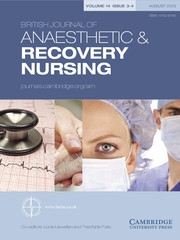WHO are we doing this for?
The patients of course! We are all becoming used to the World Health Organisation’s Safe Surgery Saves Lives Checklist now are we not? I hope you are all saying ‘yes’ because from February this year the use of the checklist became compulsory in your department. BARNA have been very fortunate in that we have been involved with Patient Safety First and the National Patient Safety Agency (NPSA) in endorsing, encouraging, advocating and embedding the use of the WHO Safe Surgery Saves Lives Checklist.
The profile of patient safety has reached a critical evolutionary point with the development of a series of tools to encourage safer practices in our operating departments. We encourage ‘adverse incident’ reporting, robust investigation and an awareness of patient safety, but still patients suffer complications following surgery, half of which may have been preventable. Even though there is an increased awareness of patient safety, it has not yet become an integral part of healthcare delivery, so it is paramount that the momentum of this initiative is maintained. It is so easy to forget, or let something slide when the ‘wow’ factor has worn off. It is vital to ensure that the widespread adoption of the principals of patient safety are maintained to demonstrate improved patient outcomes, and inevitably, cost effectiveness.
Surgery requires managing extraordinary complexities, so the WHO Safe Surgery Saves Lives Checklist is designed to be a team concern, so everyone in the operating theatre is involved in the care of the patient undergoing surgery. Many of the checks are already carried out routinely in some establishments, but the co-ordination of the whole surgical team enables the checks to be consistent and robust. Communication is so important, but I believe it is something we do not all feel confident to do. However, the checklist has broken down some of the barriers, just by the introductions in some cases. Using the checklist requires very minimal resource commitment and takes very little time once it has become familiar to the operating teams.
We must be mindful that at ‘sign-out’ we are asking, ‘What are the key concerns for recovery and management of this patient?’ Let us not forget that recovery is part of the surgical team and must be involved in the process to ensure that the patient’s surgical journey is safe and complete.
As healthcare professionals we have pledged to care for and protect our patients, therefore, we must pledge our allegiance to the WHO Safe Surgery Saves Lives Checklist and ensure that our high standards drive quality and safety of patient care, not only in our country but across the globe. So remember, by implementing the checklist, we really can save patients lives and decrease complications, avoiding endangering the lives and well being of surgical patients. It must make sense!


